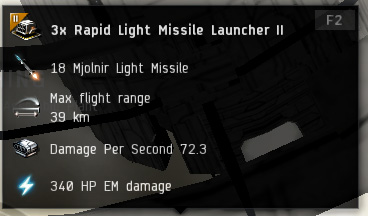| Weapon Systems |
|---|
|
|
|
|
|
|
| Other Weapon Systems |
| Other Mechanics |
Missiles are self-propelled ammunition launched from missile launchers. Unlike turret weapons, missiles have the ability to track and follow their target. Rather than optimal and falloff range, missile range is determined by velocity and flight time, while missile damage is determined by the velocity and signature radius of the target and the explosion radius, explosion velocity, and damage reduction factor of the missile.
The primary strength of missiles is that, assuming that the target is within range, a missile will always "hit" its target, but the damage dealt will vary depending on the size of the target and the speed of the explosion. However, missile launchers fire more slowly than turrets of a similar size, and missile damage is delayed due to travel time, rather than being instantaneous.
A missile does not so much hit a ship as explode near it. When a missile crosses the signature radius of its target, it blows up. The speed at which this explosion grows and the maximum size of the explosion determine the amount of damage done to the target. EVE uses a mathematical equation to compute the precise amount of damage that the explosion does to the ship.
Note that launcher ammunition is often called "missiles" regardless of the ammunition's proper name, and thus this term can refer to any of rockets, missiles or torpedoes
Missile range
When fired, a missile will leave the launcher, quickly accelerate, and then proceed at its best speed directly at the target until it runs out of fuel. If it encounters the target during that time, it will explode - otherwise it will vanish. The approximate maximum distance that a missile will travel can be found by multiplying the speed of the missile by the number of seconds that its fuel will last. (The approximation is due to eve running at 1 second intervals while missile flight time may not be a whole number.)

Maximum Distance ≈ Speed x Seconds of Fuel

For example:
- A Light Missile has a flight time of 5 seconds at a speed of 3750 m/s. The maximum distance it can travel is 5 x 3750 ≈ 18,750 m.
- A torpedo has a flight time of 6 seconds at a speed of 1500 m/s. The maximum distance it can travel is 6 x 1500 ≈ 9,000 m.
There are two special cases to missile flight time.
Eve uses 1 second ticks. If the missile flight time is not an integer then the missile will fly for integer number of seconds and has a chance to fly one more second. For example missile with flight time of 12.3 seconds has 70% propability to fly for 12 seconds and 30% propability to fly for 13 seconds.[1]
The second exception is a result of the fact that missile ranges are calculated from center of the ship while ranges on overview are calculated from "edge" of the ship. To counter this large ships get small bonus to missile flight time.[2]
This information, as modified by your skills and equipment bonuses, along with the missile's dps and type of damage, is shown when you move your mouse over the icon for a missile launcher while in space.
Although the terms "range" and "distance" are often used interchangeably, technically, the range answers the question of whether the missile can reach its target: is it "in" or "out" of range? If the target is stationary, then the maximum distance will be the missile's range. Normally, however, the target is moving, and the range depends on this motion.


If the target is moving directly away from the missile, then it will take the missile longer to reach the target than it would a stationary one. In fact, if the target is moving fast enough, the missile may not be able to reach it at all - in this case, the target would be considered "out of range." Note that the target does not have to be moving faster than the missile ... just fast enough to stay ahead of the missile until it runs out of fuel.
If the target is moving directly at the missile, then the missile will reach it much faster than it would reach a stationary target. In this case, the target may be "in range" even when it seems too far away to hit.
In most cases, however, the target will be moving in a curve with regard to the missile ship - possibly in an orbit, possibly curving towards or away from the launch. It is hard to specify the range, exactly, in these cases, but as always, the missile will head directly for the target, and it will continue as long as it has fuel. Its path is likely to be some sort of a spiral.
There is no way to control the path of a missile once it has been launched. It will point itself at its target and follow the target until it hits or runs out of fuel.
Launcher and Missile types
Each launcher class can launch missiles of that class. E.g., Light Missile Launchers launch Light Missiles, as do Rapid Light Missile Launchers. Heavy Assault Missile Launchers launch Heavy Assault Missiles. Torpedo Launchers launch Torpedoes. And so on. Different types of launchers within the class vary the firing rate and other characteristics of the launchers.
Each variety of EVE damage is available for each missile type. Inferno, Mjolnir, Nova and Scourge apply thermal, EM, explosive and kinetic damage, in that order. A given missile will apply only one variety of damage, and each missile category does the same number of hit points of damage.
Other missile types vary the flight time, base damage (hit points), and other characteristics of the missile.
- Guristas, Caldari Navy and Dread Guristas faction missiles simply have higher base damage; Guristas least, and Dread Guristas most.
- "Advanced" T2 missile types come in sets:
- Precision and Fury for long range missile launchers: Precision missiles have a faster, smaller explosion and will do more damage to a small, fast target - while Fury missiles, with their larger, slower explosions do more damage against larger, slower targets. Precision/Fury missiles are available for Light, Heavy and Cruise missile launchers.
- Javelin and Rage for short range missile launchers: Javelin long range missiles travel considerably farther. Rage missiles have a significantly larger base damage though they have poor application. Javelin/Rage missiles are available for Rocket, Heavy Assault and Torpedo missile launchers.
A launcher class and its associated missiles can be thought of as a weapons system, each of which fits best in a particular group of ships. Launchers require high power slots as well as launcher hardpoints. The power drain generally puts a lower bound on the ship size for each launcher class. Typically:
- light and rocket launchers go in frigates and destroyers
- rapid light, heavy and heavy assault launchers go in cruisers and battlecruisers
- rapid heavy, torpedo and cruise launchers go in battleships
- torpedo launchers also go in T2 frigate Stealth Bombers, which have specialized attributes to accommodate them.
- citadel and rapid torpedo launchers go in capital ships
Other missile types:
- Defender missiles. When activated, Defender Launchers will scan local space for bombs within range. If a bomb is detected, the launcher will fire one Defender Missile to intercept and destroy it. If no bombs are found, the launcher will still cycle. The Defender Launcher has 120-second reactivation timer.[3]
- When fired, an Auto-Targeting Missile will locate and target the nearest enemy ship or drone which has previously fired on you. Since they cannot be aimed, auto-targeting missiles are usually passed over in favor of regular missiles.
Skills
These skills apply to all missile launchers. They increase firing rate and damage, and they improve the accuracy of missiles against smaller, faster targets.
- Missile Launcher Operation 2% Bonus to missile launcher rate of fire per skill level. This gives a bonus to DPS — and it is a prerequisite for many other missile skills.
- Rapid Launch 3% bonus to missile launcher rate of fire per level. Essentially, a DPS increase.
- Warhead Upgrades 2% bonus to all missile damage per skill level. Another DPS increase, smaller than Rapid Launch, but still worth training.
- Missile Bombardment 10% more flight time for all missiles per level. If you are planning to use a long range or "kiting" strategy, train this higher.
- Missile Projection 10% bonus to all missiles' maximum velocity per level. Another range increase that is especially useful for "kiting".
- Guided Missile Precision 5% reduction in missile explosion radius per level of skill. Proficiency at this skill increases damage to small targets.
- Target Navigation Prediction 10% increase in missile explosion radius per level. As with Guided Missile Precision, this makes missiles more effective against faster targets.
In addition to the general missile skills there is a specific primary missile skill for each class of missiles, and each will let you load and fire that one class. In addition, each level of the skill will improve your damage by 5% when using that particular missile class.
- Rockets
- Light Missiles
- Heavy Missiles
- Heavy Assault Missiles
- Cruise Missiles
- Torpedoes
- XL Cruise Missiles
- XL Torpedoes
- Auto-Targeting Missiles
- Defender Missiles
All the missile types also have a "Specialization" skill. This gives you access to T2 launchers and missiles, and it provides a 2% bonus per level to the rate of fire of modules that require the specialization (mostly the T2 modules). All of these require that you have trained the Primary Skill to Level V, so they are usually pursued after your other training is complete.
- Rocket Specialization
- Light Missile Specialization
- Heavy Missile Specialization
- Heavy Assault Missile Specialization
- Cruise Missile Specialization
- Torpedo Specialization
- XL Cruise Missile Specialization
- XL Torpedo Specialization
Equipment
- Widely used equipment is listed here. See Fitting Missile Launchers for a more complete list.
Ballistic Control Systems are passive, low slot modules which increase missile damage and rate of fire. Stacking penalties apply, but many larger ships still fit three of them. Target Painters increase the signature radius of a target and make it easier to hit.
Missile Launcher Rigs come in four sizes, one for each sized launcher. All of the rigs have an increase in CPU use as their penalty. The Bay Loading Accelerator increases the rate of fire, the Hydraulic Bay Thrusters increase missile velocity, and the Warhead Calefaction Catalyst increases missile damage. Also of potential use are the Targeting Rigs, especially the Small Ionic Field Projector, which increases targeting range.
Tactics and Strategy
Turrets versus Launchers
It is difficult to compare qualitatively different weapons systems based on technical specifications. For example, here are two close range systems that are often mounted on Frigates.
| Launcher | Power (MW) | Firing Rate (s) | Reload Time (s) | Missile Type | Flight Time (s) | Velocity (m/s) | Explosion Radius (m) | Explosion Velocity (m/s) | Base Damage (hp) |
|---|---|---|---|---|---|---|---|---|---|
| Rocket | 4 | 5 | 10 | Rocket | 2 | 2,250 | 20 | 150 | 33 |
| Turret | Power (MW) | Firing Rate (s) | Reload Time (s) | Optimal Range (m) | Falloff (m) | Tracking Speed (rad/s) | Damage Modifier | Charge | Base Damage (hp) |
|---|---|---|---|---|---|---|---|---|---|
| Ion Blaster | 4 | 2 | 5 | 1,000 | 1,500 | 0.438 | 1.8 | Lead | 8 |
| The first problem is that although both systems function by delivering damage at a distance, the turret's primary effectiveness is based in the blaster, while the launcher's primary effectiveness is based in the rocket. And it is very hard to compare the tracking speed, optimal range and falloff of the one with the flight time, explosion radius and explosion speed of the other. <br\><br\>In addition, the chart cannot take into account the ability of the pilot to keep the blaster within tracking range on the one hand, nor the ability of the pilot to evade damage while the rockets travel to the target on the other. <br\><br\>Consequently, the decision to use rockets over blasters or vice-versa should not depend on a comparison of the two weapons systems, but rather on a comparison of pilot and ship abilities. Does your ship have bonuses for one type of system or the other? Is it better suited for an armor tank (blasters) or shields (rockets)? And does the pilot have roughly the same skills in rockets as in blasters?<br\><br\> The bottom line: don't waste time debating over weapons systems. Improve your skills, find a ship that matches, and then find the right fit for that ship. |
Damage and range
As noted in the article on missile damage:
In other words, missile weapons are best at doing damage to larger, slower targets at longer range. This is not to say that a pilot cannot kill small, fast targets with the right missiles, or that there are no short range missile boats. Rather, the most common applications of launcher fitted ships tend to be as longer ranged, heavy damage weapons.
Fleet roles
Because missiles are usually most effective against bigger, slower targets, missile ships in fleets often find themselves in the "sniper" role — assigned to picking off specific enemy targets (such as logistics vessels). In small fleet encounters there may be few, if any, such targets, and the encounter may in fact be over before the missile ship's damage begins to matter. As a result, missile ships are most often found in larger fleets.[4]
Kiting
As a strategy "kiting" is a plan to engage the enemy from a distance, always fleeing just fast enough to stay outside of the enemy's range while remaining inside your own range. Since kiting ships need speed and longer ranged weapons, shield tanked missile boats are good for this approach.
As a tactic, kiting requires a "hit and run" mentality. You want to approach your target until you are close enough to shoot, fire a salvo of missiles, and watch. If the enemy flees, you want to pursue; if the enemy attacks, you want to flee ... at a speed approximately the same or a bit more than the enemy ... firing all the time. Because missiles will chase the target without any further guidance from your ship, you are not restricted to any particular flight path. You simply want to stay within missile range of the target.
PvE enemies tend to be rather fanatical, locking on when they see you and never giving up. This makes kiting a popular strategy when running Missions. It takes longer to kill the NPCs, and the resulting loot can be scattered over a wide area, but your ship will take relatively little damage, and since you are already running, if you decide to break off, it is usually easy to get away.
PvP is much more difficult in this regard. Inexperienced pilots may chase you to their deaths, but experienced pilots will just let you run. PvP kiting is more likely to show up in gangs of fast ships that hit and run from multiple directions at once ... a kind of "wolfpack" attack that leaves their target unable to either run or close on a target.
Footnotes and references
- ^ If the flight time is a fraction, EVE rounds it up or down. At times, this produces considerable departures from the computed range. See Interesting fact about missile mechanics for details.
- ^ https://forums.eveonline.com/default.aspx?g=posts&m=6523910#post6523910
- ^ Defender Missile update announcement
- ^ There do exist doctrines for entire fleets of missile ships. Fleets of Stealth Bombers, for example, are common, and there is even an E-UNI group, the UniBombers, dedicated to this style of combat.







